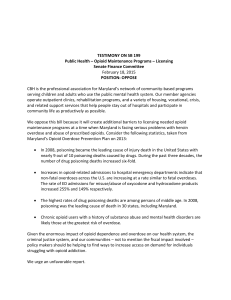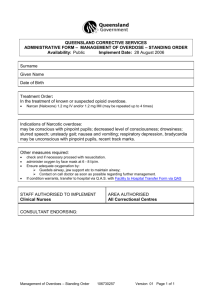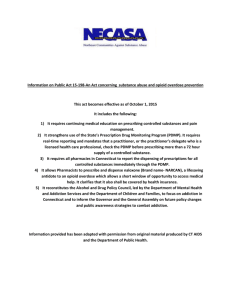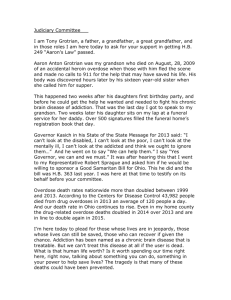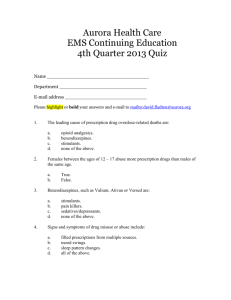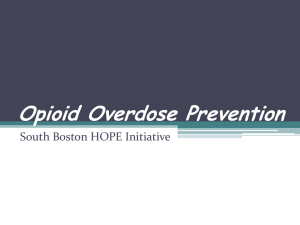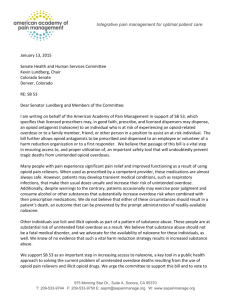Maryland Local Overdose Fatality Review Teams Research Project
advertisement
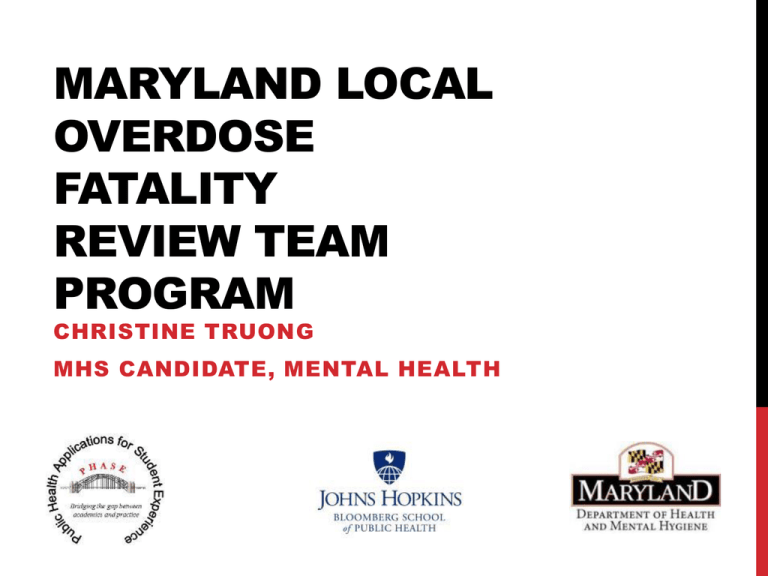
MARYLAND LOCAL OVERDOSE FATALITY REVIEW TEAM PROGRAM CHRISTINE TRUONG MHS CANDIDATE, MENTAL HEALTH OUTLINE • PHASE Internship Overview • Opioid Addiction and Overdose • Research Project Description • Public Health Significance PHASE INTERNSHIP EXPERIENCE Legislative Research & Policy • Conducted literature searches • Drafted policy regarding legislator visits to BHA-funded mental health facilities Behavioral Health Research • Poisoning Characterization Project • Maryland Local Overdose Fatality Review (OFR) Team Program • Continue work with project towards publication OPIOID ADDICTION AND OVERDOSE • Opioid related addiction and overdose affects between 26.4 million and 36 million people worldwide1 • In the United States, between 2000 to 20142: • Drug overdose death rate has increased 137% • Rate of opioid related overdose deaths has increased 200% • In 2014, 47,055 drug overdose deaths occurred in the United States2 • 6.5% increase from the previous year • Same upward trend continues into 2015 • In Maryland, between 2010 and 20143: • Number of heroin-related deaths has more than doubled • Number of opioid-related deaths has increased by 76% 1. 2. 3. UNODC (2012). World Drug Report 2012 Rudd, R. A., Aleshire, N., Zibbell, J. E., & Gladden, R. M. (2016). Increases in drug and opioid overdose deaths-United States, 2000-2014.MMWR: Morbidity and mortality weekly report,64(50-51), 1378-1382 Maryland Department of Health and Mental Hygiene (2014). Drug- and Alcohol-Related Intoxication Deaths in Maryland, 2014 THE COSTS OF OPIOID ADDICTION Financial: • Approximately $53 billion annually Biological: • Higher association and rates of HIV/AIDS, hepatitis B and C, and tuberculosis • Higher risks of premature death, STDs, liver disease from alcohol abuse, and other physical and mental health problems Social: • Increased crime, increased disease transmission, increased health care costs, and destabilized communities OVERDOSE FATALITY REVIEW TEAMS What is overdose fatality review? • Modeled after other fatality review teams such as CFR, FIMR, or DVFR teams • Representatives from multiple agencies assemble to confidentially review cases of overdose death • Teams compile individual level data from multiple stakeholders who are involved in the community OVERDOSE FATALITY REVIEW TEAMS What is the goal? • Prevent future deaths by: • Identifying missed prevention opportunities and system gaps • Increasing collaboration between local stakeholders on overdose prevention • Recommending policies, programs, laws to prevent overdose deaths • Informing local overdose prevention strategy RESEARCH PROJECT PURPOSE Build upon findings from DHMH publication Development of Maryland Local Overdose Fatality Review Teams: A Localized, Interdisciplinary Approach to Combat the Growing Problem of Drug Overdose Deaths • Process of establishing three pilot LOFRTs in Maryland • Potential as an effective tool to combat overdose Currently, project has grown and consists of 18 teams METHODS AND APPROACH Mixed methods • Examine quantitative and qualitative data collected from 2014 and 2015 In order to: • Identify risk factor trends and outcomes across various demographic characteristics and counties. • Explore and compare categorizations of program and systemic recommendations • Developed by OFR teams to inform strategy for overdose prevention at the state and local levels METHODS & APPROACH 1. Completed data entry to OFR database • Collected information Includes: • Circumstances surrounding death, drugs identified in case, entities that collaborated for investigation, risk factors, program changes, and systemic recommendations 2. Identified potential database modifications and expansions 3. Qualitative analysis of team observations • Codes include: • Physician engagement, medical care coordination, behavioral health services integration, systems coordination, judicial system capacity building, and public assistance programs interventions 4. Quantitative analysis • To determine: • Ranking of trends and reach points by demographic characteristics and county OFR PUBLIC HEALTH SIGNIFICANCE Identify systemic and policy changes that will prevent similar deaths in the future Recommendations will have long-term impacts Strengthen communication and coordination between participating agencies This project is essential because: • Help those suffering with substance use disorder but also their families, the communities they live in, and service providers. • By examining risk factor, outcome, and recommendation trends across demographic characteristics and counties: • Potential to identify and inform overdose prevention needs and priorities for increased effectiveness. ACKNOWLEDGEMENTS Department of Health and Mental Hygiene (DHMH) Gayle Jordan-Randolph Erin Haas Lisa Hadley Rianna Matthews-Brown PHASE Internship Program Paulani Mui Beth Resnick REFERENCES Drug Enforcement Administration. 2014 national drug threat assessment summary. Washington, DC: United States Department of Justice; November 2014 - See more at: http://www.ajmc.com/journals/supplement/2015/ace0029_aug15_painrems/ace0029_aug15_painrems_fudin/P3#sthash.SxWAbPEZ.dpuf Haas, E. (2016). Development of Maryland Local Overdose Fatality Review Teams: A Localized, Interdisciplinary Approach to Combat the Growing Problem of Drug Overdose Deaths. Health Promotion Practice. Accepted. Kampman, K., & Jarvis, M. (2015). American Society of Addiction Medicine (ASAM) National Practice Guideline for the Use of Medications in the Treatment of Addiction Involving Opioid Use. Journal of addiction medicine, 9(5), 358. Leavitt, S.B. (2004). A Community-Centered Solution for Opioid Addiction Methadone Maintenance Treatment (MMT). Addiction Treatment Forum. Maryland Department of Health and Mental Hygiene (2014). Drug- and Alcohol-Related Intoxication Deaths in Maryland, 2014. Maryland Department of Health and Mental Hygiene. Drug Overdose Fatality Review Program Guidance Document. Maryland Department of Health and Mental Hygiene. Overdose Fatality Review Justice Clearing House Webinar. Rudd, R. A., Aleshire, N., Zibbell, J. E., & Gladden, R. M. (2016). Increases in drug and opioid overdose deathsUnited States, 2000-2014.MMWR: Morbidity and mortality weekly report,64(50-51), 1378-1382. Schwartz, R. P., Gryczynski, J., O’Grady, K. E., Sharfstein, J. M., Warren, G., Olsen, Y., ... & Jaffe, J. H. (2013). Opioid agonist treatments and heroin overdose deaths in Baltimore, Maryland, 1995–2009.American journal of public health, 103(5), 917-922. UNODC (2012). World Drug Report 2012.
